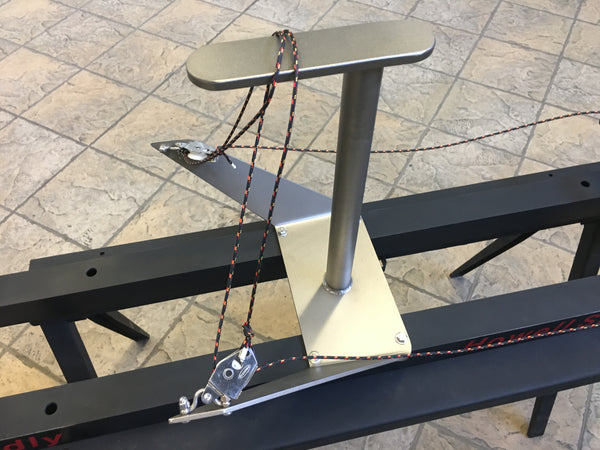Howell Test Fixture (sm)
Optional — to provide bespoke additional lateral-heel release-settings for Howell Ski Bindings.
Available now.
Howell Test Fixture (sm) can be used to validate, demonstrate and calibrate bespoke, additional, lateral-heel settings for Howell Ski Bindings.
Lateral-heel release is not rotational-heel release: no boot can pass laterally thru the side-lugs of a turntable / pivot heel. This is why turntable / pivot heels can cause ACL, MCL, meniscus, and tibial-plateau injury.
Lateral-heel release together with lateral-heel release-settings that are generated through the use of the Howell Test Fixture — can provide enhanced, personalized ACL, MCL, meniscus, and tibia integrity during alpine skiing. No binding, including Howell Ski Bindings, can completely eliminate ACL, MCL, meniscus and tibia injury. Detailed instructions included.
Photo 1. Howell Test Fixture bolted to bench. Bolts not supplied.
Photo 2. Howell Test Fixture firmly holding an alpine ski-boot upside down.
Photo 3. Ski held only by the binding. Boot held only by the Howell Test Fixture.
➡️ Made of solid, one-piece, 303 stainless-steel — the Howell Test Fixture also includes 2 stainless-steel micro-fiddle V-blocks and 2 high-strength sailing lines. Bench and mounting-bolts are not included. Total shipping weight including sturdy wooden shipping container: 12 pounds. FOB Granby, Québec, Canada.
Available now.
________________________________
To pre-order Howell Ski Bindings with an $80 reservation-deposit:
Howell Venus DIN 3-8 For smooth recreational female skiers. Extra ACL, MCL, meniscus, tibia - integrity - expressly for women. 4-modes of release. Additional lateral-heel release. Additional vertical-toe release. Excellent edge control. Easy step-in even in deep powder with short boot soles. Lite.
Howell Mars DIN 4-10 For strong, smooth recreational skiers. ACL, MCL, meniscus, tibia - integrity. Anti-pre-release. Powerful edge-control. Low stand-height. Decisive balance of release and anti-pre-release.
Howell Planet-B DIN 8-22 Only for strong adult racers and extreme skiers. High strength aluminum alloy housings. Super-wide 8-point boot-contact for ultra max edge control. Wide off-center release-pivots provide max anti-pre-release. Low 21.5mm standheight allows race-plates conforming to FIS standheight regulations (race plates not included). Floating Mounting System mitigates binding pull-out’s from skis. 1, 2, 3 - degree cant kit, including longer mounting screws for the cants. Adjustable toe-height for solid boot interface. CAUTION: PLANET-B IS FOR EXTREME SKIERS & RACERS ONLY.

Howell Ski Bindings (sm)
PO Box 1274 • Stowe, Vermont 05672 USA
1.802.793.4849 • rick.howell@howellskibindings.com
__________________________
Copyright © by Rick Howell and Howell Ski Bindings, 2025. All rights reserved. U.S. Patent 9,463,370. Content subject to change without notice.
'ACL-integrity', 'Anti-Pre-Release', 'It was inevitable.', 'Howell Ski Bindings', 'Howell Venus', 'Howell Mars', 'Howell PlanetB’, Howell Planet-B’ — are Service Marks (sm) of the company, Howell Ski Bindings .




